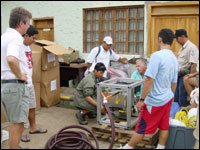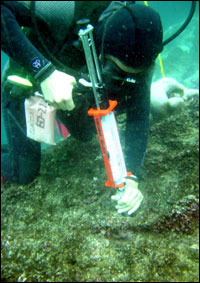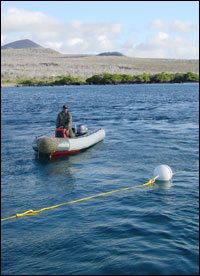 | ||||||||||||||||||||||||
|
|
|
|
|

Acting on a request from the U.S. Agency for International Development (USAID)/Ecuador and the Galapagos park and reserve, the NMSP trained Ecuadoran locals on how to place the buoys and leave them with the skills to continue installing them throughout the Galapagos Islands. "NOAA recognizes the connectivity of the world's oceans and the importance of working internationally to sustain and conserve ocean resources," according to Brady Phillips of the sanctuary program, who coordinated the mooring buoy installation project. "And in supporting NOAA's mission, the National Marine Sanctuary Program believes our own experience in working with local communities and stakeholders to resolve complex resource management issues can be shared and tailored to fit specific needs in the Galapagos."
Additionally, the archipelago's rich waters are home to over 300 species of fish, the green pacific sea turtle that lay their eggs on the islands from December to June, and numerous sea lions and dolphins. But like all sensitive marine ecosystems, the Galapagos can fall prey to human disturbances. Installing mooring buoys is a move in the right direction to protect the region's seafloor from anchoring which can disturb, and in many cases, destroy key invertebrate communities and soft coral that form a necessary component of the islands marine environment.
"Conventional mooring buoys use heavy cement blocks situated on the sea floor with chain and a floating buoy," says Halas. "The block and chain are subject to heavy drag causing damage to corals. Our buoys, first used in Florida's sanctuary waters in1981, involves drilling a hole into hard limestone or dead coral and cementing a stainless steel eye into the core. This system is firm and drag-free. From the eye, a line is floated to the surface to the buoy."
A year before the buoy trip, NMSP staff visited the islands and began a partnership to look at ways to strengthen the islands' ability to address ecosystem management challenges, and help the Galapagos meet their long-term goals and objectives for the marine reserve. The NMSP also has partnerships with Australia, Italy and South Korea to share knowledge about managing protected areas in the ocean. Click here to learn more about the sanctuary program's international activities. The Galapagos project was funded by the National Marine Sanctuary Foundation. |

|
|
||||||||||||||||||
|
||||||||||||||||||||||||








